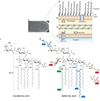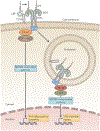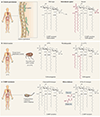Fortifying the barrier: the impact of lipid A remodelling on bacterial pathogenesis
- PMID: 23748343
- PMCID: PMC6913092
- DOI: 10.1038/nrmicro3047
Fortifying the barrier: the impact of lipid A remodelling on bacterial pathogenesis
Abstract
Gram-negative bacteria decorate their outermost surface structure, lipopolysaccharide, with elaborate chemical moieties, which effectively disguises them from immune surveillance and protects them from the onslaught of host defences. Many of these changes occur on the lipid A moiety of lipopolysaccharide, a component that is crucial for host recognition of Gram-negative infection. In this Review, we describe the regulatory mechanisms controlling lipid A modification and discuss the impact of modifications on pathogenesis, bacterial physiology and bacterial interactions with the host immune system.
Conflict of interest statement
Competing interests statement
The authors declare no competing financial interests.
Figures




References
-
- Nummila K, Kilpelainen I, Zahringer U, Vaara M & Helander IM Lipopolysaccharides of polymyxin B-resistant mutants of Escherichia coli are extensively substituted by 2-aminoethyl pyrophosphate and contain aminoarabinose in lipid A. Mol. Microbiol 16, 271–278 (1995). - PubMed
-
- Guo L et al. Regulation of lipid A modifications by Salmonella typhimurium virulence genes phoP-phoQ. Science 276, 250–253 (1997). - PubMed
-
- Guo L et al. Lipid A acylation and bacterial resistance against vertebrate antimicrobial peptides. Cell 95, 189–198 (1998). - PubMed
Publication types
MeSH terms
Substances
Grants and funding
LinkOut - more resources
Full Text Sources
Other Literature Sources

